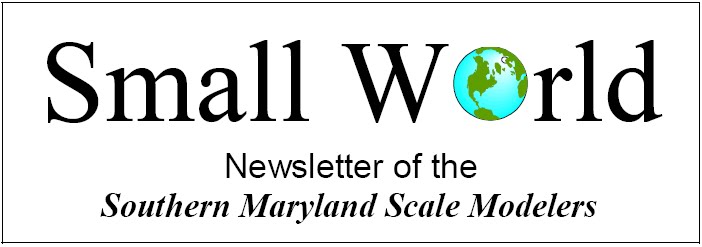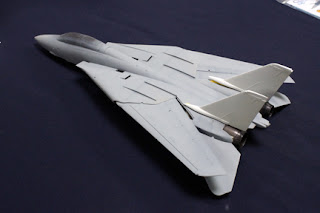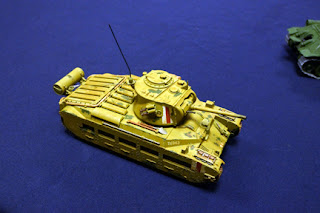By Tim Holland
 Most of us remember our first model. Some of us only remember the type, or the circumstances, but not always THE model. A rare few of us actually still HAVE that first model.
Most of us remember our first model. Some of us only remember the type, or the circumstances, but not always THE model. A rare few of us actually still HAVE that first model.
November's club meeting focused on what that first model was, and if you could identify it, build it again. A car showed up, mostly aircraft, but mainly just stories. Stories about what that first kit was and how we came to have it. How we built it (you use the whole tube for the kit, right?). How we painted it (curing time between colors, why?). And the ultimate demise of the model, whether from fire crackers, BB guns or just rocks.
My own story begin at age 5-ish. Dad brought home two models of airliners. He made them both and I got one while my younger sister got the other. We flew those around the house together until they were demolished or we bored of them, probably just a few hours later. But I remember watching Dad build it with lots of anticipation on my part. And I remember the landing gear coming off shortly after my hands got on it, but it still flew just like the real thing!
The next model I remember is a silver jet. I remember building it myself and the stickers didn't work so well; and there was no paint. I remember being 8 or 9 and during some warm days that jet met its fate in an imaginary firey crash near those green army men the jet was attacking. But what was that model?
By the time I was 10, I had a number of ship, car and airplane models. The ship models floated (somewhat) in my Nana's pond and the airplane models attacked. It was that summer I lost interest in cars and started my focus on 1/72 scale. Revell had released a double kit of the F4F Wildcat and A6M Zero. Constant scale meant my models looked more real next to each other! By Christmas I had nearly all their 1/72 scale aircraft hanging from my ceiling...but I digress.
I still have that Revell Zero. It comes out at Christmas and takes a place of honor on the tree. So I decided to find the Wildcat and another Zero and try my hand at those kits 40+ years later...but fate intervened.
While scanning photos from old albums I came across this photo of a smiling new 8 year old holding his new GI Joe and waiting for the "go!" to dive into those birthday cupcakes. Look at what's in the lower left corner: A Hawk Gloster Javelin. Could it be? I searched eBay and for $7 one in the same boxing was en route. A week later I opened the box to find silver plastic and a very familiar feel! I had found my "first" model!
The Subject
Who knows?! This is a sleek, modern, fast delta winged jet. "Javelin" -- It has a name that sounds fast and dangerous. Nothing like it flies over Arkansas and with TWO jets I bet it makes lots of noise. It's got these missiles for shooting things up and all these other bits that go under the wings, but who needs them? If I make it ready to fly without that stuff it won't break off and I can actually shoot the missiles at things like ships, tanks, green army men and other airplanes (where is that B-17?).
And it's BIG. Almost too big for that little boy's hands. But if he uses enough glue it'll be solid and perfect with his Hot Wheels and Matchbox cars.
The Javelin was an all-weather interceptor for the RAF, operating throughout the '60's. It was a contemporary of the McDonnell-Douglas F3H Demon and F-101 Voodoo with comparable performance and capabilities.
The Model
 Hawk produced this kit in the '60's. It is typical for the day with lots of raised detail, rivets the size of tennis balls and even the national markings are represented by raised detail. The cockpit is non-existant, with a pilot that sits on a plank, even though it is called a seat. The landing gear doors are molded shut, however separate doors are provided to display the model with the gear down. There is no intake or exhaust detail, one can look down one end and see through to the other.
Hawk produced this kit in the '60's. It is typical for the day with lots of raised detail, rivets the size of tennis balls and even the national markings are represented by raised detail. The cockpit is non-existant, with a pilot that sits on a plank, even though it is called a seat. The landing gear doors are molded shut, however separate doors are provided to display the model with the gear down. There is no intake or exhaust detail, one can look down one end and see through to the other.
One site infers Hawk made identification models for the US, of which the Javelin was one, and after that contract expired they used the molds and sold the kits to the public.
The kit is considered inaccurate for a production Javelin. At best it represents one of the prototypes that flew with just the forward seat. The nose, canopy, wings, exhausts, intakes are all wrong. But who cares? This was a fun model for a kid; and as an identification model, it's close enough to a Javelin in appearance to pass.
I didn't use all my skills on this one, I wanted conversation piece to go with that photo. I DID paint it this time, as is obvious in the photos. I filled the seams, the top and bottom halves of the fuselage don't fit well. The outer wing panels left noticeable gaps on the wings, but instead of filling and sanding all that detail away, I drizzled some Future and other thin glues into it to make it better (good enough anyway). I had to fair the canopy in; I used strip styrene to raise the rear portion so it had a better profile. Otherwise it would have had a 1/8th inch step behind it and I wanted to limit sanding.
Decals were yellowed but they worked just fine with Micro-Sol. The white turned out to be the same shade as Floquil Antique White, so I touched up the fin flash where each side didn't quite meet. A final coat of Future mixed with Acryl Clear Flat toned down the sheen just a bit. I put it on its stand and voila! My first model.
Thanks for reading...



























































